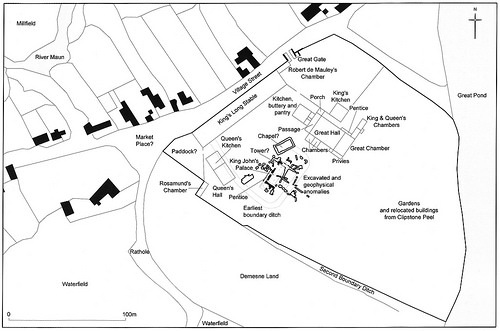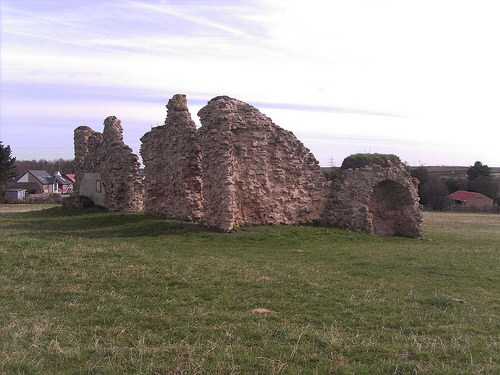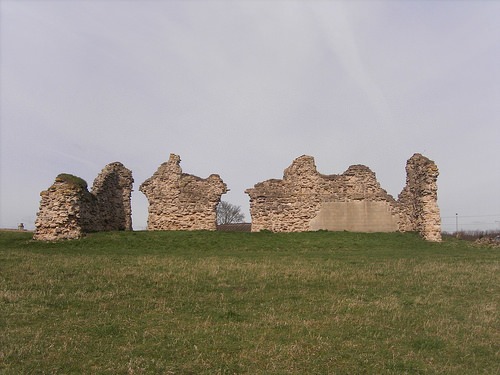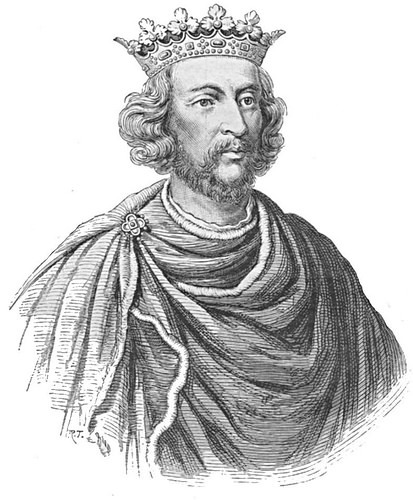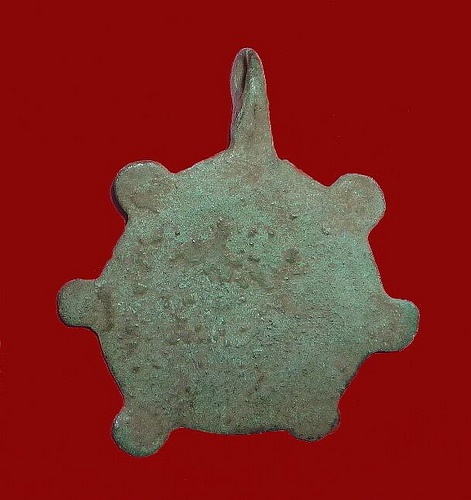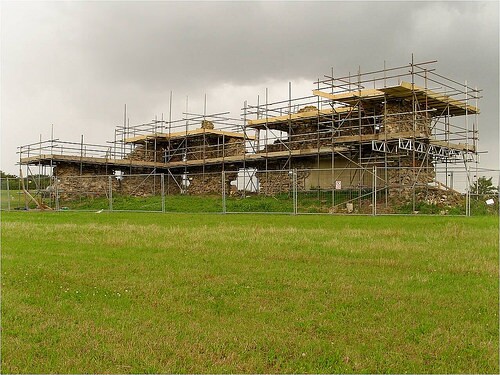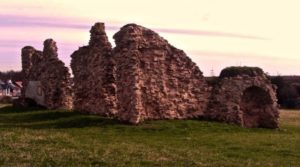
On a hill overlooking the confluence of two small rivers, in the heart of Sherwood Forest, England, is an unassuming, ruined stone building. The roofless structure stands in splendid isolation on the edge of the village of Kings Clipstone in Nottinghamshire. Known locally as ‘King John’s Palace’, it was thought for much of the twentieth century to be nothing more than a mere hunting lodge associated with a nearby 1,500-acre medieval deer park. However, intensive archaeological and historical research over the past twelve years has shown that the ruin was once part of an enormous royal palace, known as the King’s Houses, that stretched over seven and a half acres and was visited by eight of the Plantagenet kings.
The first serious study of the site took place in 1890 by local researcher Alfred Stapleton. However, he arbitrarily misrepresented the site as nothing more than a hunting lodge. Unfortunately, he was followed in this interpretation, during the mid-twentieth century, by influential academics such as buildings historian Nikolaus Pevsner, archaeologist Philip Rahtz and architectural historian Howard Colvin. A fundamental reassessment of the evidence has taken place over the last twelve years, which has included a wide range of research techniques such as map-regression, documentary analysis, standing building survey, field-walking, geophysics, metal detecting, test-pitting and archaeological evaluation. The work has managed to establish the true scale of the site, as well as specifically identify the original use of King John’s Palace as a twelfth century great hall, and has pinpointed the locations of the great gate and a possible chapel. It has also produced an array of artifacts such as coins, a seal matrix, book clasps and horse pendants.
__________________________________________
Composite map of the ground plan of the King’s Houses, Clipstone in the fourteenth century.
______________________________________________
King John’s Palace, looking north-east, viewed from a similar direction to several antiquarian illustrations made of the building in the eighteenth century.
______________________________________________________________
The former interior of King John’s Palace, looking north-west, the openings in the center and to the left are relict doorways whereas the masonry blocking to the right was inserted during 1991.
_______________________________________________________________
The origins of the King’s Houses date to 1164 when Henry II established a base in Sherwood Forest, from which to engage in his beloved pursuit of hunting. By 1176, the king was thinking on an even grander scale. He had recently defeated a rebellious coalition of enemies led by his own sons and was free to express his enormous power. The king used two methods to do this: tightened control of the royal forests, coupled with a redistribution of castles amongst his supporters. There was no better time for the king to begin expanding his own residence in the royal forest of Sherwood.
When Henry II’s son, Richard, briefly visited Clipstone in 1194 (during a tactical meeting with his ally, William the Lion of Scotland) he was enormously pleased with the facilities that he had inherited from his father. Alongside the vast deer park, enclosed within a timber pale fence, was a huge lake to the east of the palace. Rising above the lake on the slopes of the hill was a complex of buildings including a hall, chamber and chapel which were surrounded by a D-shaped enclosure ditch and palisade. The standing ruin was almost certainly the great hall which was built in the French style, with the main room at first floor level. It was modeled after St. Mary’s Guildhall in Lincoln and was constructed in the Romanesque fashion, complete with an elaborately moulded central doorway and great, round-headed windows.
The King’s Houses remained this way throughout the reign of Richard’s younger brother, John. Despite visiting Clipstone on seven occasions, John made little impact on the site beyond ordering necessary maintenance and repair work. The name ‘King John’s Palace‘ only became associated with the standing ruin during the eighteenth century, when antiquarians were keen to associate many medieval buildings with the notorious king.
It was John’s son, Henry III (pictured right), who dramatically remodeled the King’s Houses during the 1240s and 50s and truly turned the site into a sprawling palace, complete with a new timber-framed great hall, a great chamber, a new chapel, another hall, chapel, kitchen and wardrobe for Queen Eleanor of Provence, as well as chambers with chimneys and privies for both king and queen. This was all surrounded by a new palisade which extended far beyond the original enclosure and was accessed by a great gate.
Henry III was extremely influenced by the new Gothic style of architecture characterized by pointed arches and traceried windows. In particular, the buildings of France and of Queen Eleanor’s native land of Savoy provided inspiration, and during his reign, Henry authorized over £30,000 on building projects. However, it was partly this lavish spending which ultimately led to the rebellion of his own brother-in-law, Simon de Montfort, during the 1260s.
The King’s Houses at Clipstone had various purposes. Just one day’s ride from the great royal castle at Nottingham, they provided a base for hunting in Sherwood Forest. Hunting the red, fallow and roe deer that inhabited the oak and birch woodlands of the region was an activity legally reserved for the monarchy and as such was a powerful statement of the status of the participants. Deer bones excavated at the site have shown a preponderance of meat selected from the right side of the carcass. This reflects the medieval ritualized butchery of the animal – the highest status hunters were offered venison cut from the right side. Equally, the palace was designed to maximize the status of the king through lavish architectural statements such as high quality stone-carving and substantial buildings that, when seen from the outside, must have appeared densely clustered around a number of courtyards to create the impression of a large village.
By the fourteenth century, the entire landscape around the palace had been developed to provide a romantic, idealized backdrop with stage-managed views via deliberately cleared areas of land known as ‘launds’, which were framed by the wild wood on the fringe of the lordship. This type of landscape was observed by the contemporary author of the poem Sir Gawain and the Green Knight when he wrote of: ‘high walls in a moat, on a mound, bordered by the boughs of thick-trunked timber which trimmed the water. The most commanding castle a knight ever kept, positioned on a site of sweeping parkland with a palisade of pikes pitched in the earth in the midst of tall trees for two miles or more.’ (Quoted from Simon Armitage’s translation of the poem published by Faber & Faber).
The palace is perhaps best remembered for the parliament held there in the autumn of 1290. It was summoned by Edward I, with the primary objective of making arrangements for a renewed crusade in the Holy Land. What is less well known is that it was the only parliament not based either at Westminster or at a location related to his wars in Wales. The parliament took place at Clipstone because Queen Eleanor of Castile was simply too ill to make a journey south. Within days of the end of the 1290 parliament, Eleanor had died.
Medieval monarchs were itinerant and moved between residences so that they could personally dispense justice, patronage and power. Their household retinues numbered perhaps 150 during the Norman period, but by the time of Henry VI, the mobile court consisted of around 800 souls. Such numbers required large amounts of food and, as a result, the king had to move around his estates on a regular cycle so as not to drain the produce and resources of a single manor. This necessity became apparent during the winter of 1315-16, when Edward II spent over three months at Clipstone and was forced to send foragers far out across the River Trent into Lincolnshire. Their mission was to provide food for the household that had already managed to consume over 1,700 fish caught in the lake east of the palace.
The King’s Houses provided the backdrop for many events above and beyond hunting. In 1316-17, whilst at Clipstone, Edward II brokered peace with Scotland through the diplomatic intervention of the papal envoy Ammenenus de Pelagrua. Early in his reign, Edward III held two tournaments at Clipstone. The second of these, in January 1328, took place at night and the king rode out in a new suit of armor, covered with a purple velvet surcoat – stitched with 21,800 golden threads, depicting crowns and oak leaves, it must have caught the necessary torchlight enchantingly. Later on in his reign, Edward III and Queen Philippa of Hainault attended the wedding of two of their retainers at the palace chapel in 1337.
Building projects continued through the late thirteenth and fourteenth centuries. Edward I ordered new apartments for himself and the queen, and in 1283 he commanded the construction of an astonishingly large building known as the King’s Long Stable, which was capable of housing two hundred horses. In 1316, Edward II was suffering major political setbacks related to the economic recession, created by a decline in environmental conditions, unsuccessful wars in Scotland, and an ongoing tension with his cousin, the Earl of Lancaster. He chose to improve his personal security by constructing a fortification, three miles southwest of the King’s Houses, known as Clipstone Peel. This fort also commanded an extensive agricultural enterprise, intended to provide food for the household at a time of terrible crop failure. During the second half of the fourteenth century, both Edward I and Richard II engaged in large programs of repair work, particularly after a great storm in 1360 which caused extensive damage, requiring the employment of stonemasons, carpenters, sawyers, plumbers, carters and many laborers.
During March 1396, Richard II was the last monarch to spend time at Clipstone. Throughout the fifteenth century, the site had been granted by the Crown to a number of household retainers and relatives as interest in the isolated residence began to wane, in favor of houses and castles located more conveniently near London and the southeast. Although the palace continued to be maintained into the 1440s, no other monarch ever visited and the buildings began to slip into what was described in 1525 as ‘great decay and ruin in stonework, timber, lead and plaster.’ By the early years of the seventeenth century, only the roofless ruin of King John’s Palace was standing as successive generations had robbed the stone and timber structures for other building projects such as the construction of nearby Clipstone Hall.
Under the ownership of the dukes of Newcastle and later the dukes of Portland, the site of the King’s Houses became nothing more than an agricultural field managed by their tenant farmers. Interest in the medieval site was once again sparked towards the end of the seventeenth century by Robert Thoroton, when he wrote The Antiquities of Nottinghamshire. This work was followed up by a number of other antiquarians such as Francis Grose, Major Hayman Rooke and Samuel Hieronymous Grimm, who wrote about and illustrated the ruins during the eighteenth century. Despite this, further disaster struck the site in the early nineteenth century when the intensive remodeling of the village of Clipstone, coupled with the Duke of Portland’s flood meadows irrigation scheme, led to the foundations of the site being quarried for stone.
_____________________________________________
Silver penny of Edward I excavated in 2012 (David & Anthony James)
_____________________________________________________________
Mediaeval horse pendant from Clipstone (David & Anthony James)
____________________________________________________________
King John’s Palace photographed in 2009 during a program of comprehensive conservation carried out by Paul Mendham Stonemasons.
____________________________________________________________
It is true to say that the archaeological remains of the King’s Houses are in very poor condition as a result of repeated quarrying of foundations, which has left only minimal traces in situ, largely characterized by robber trenches. However, it is also true to say that multidisciplinary research has been employed successfully to once again understand the great significance of the once-great palace at Kings Clipstone, and the role it played in the history of medieval monarchy in England.
_____________________________________________

